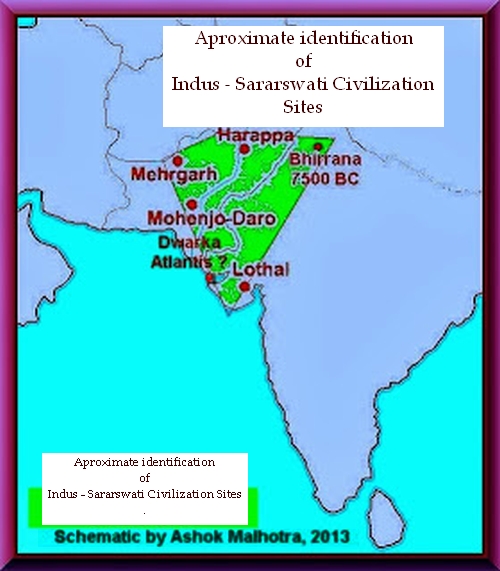Tracing the origin of Ancient Sumerians
It is of considerable interest to trace where the ancient Sumerians emerged from because of their primary contribution to human civilization. It was suggested that Sumerians appeared in Southern Mesopotamia around five and half thousand years ago carrying with them the seeds of civilization. It was also suggested that they migrated from the west coast of India. The fact that they were not a local people is suggested by the fact that their language belongs to a completely different and isolated group. There are two further lines of investigation one may adopt to confirm this hypothesis. The first is to explore for other groups in India with a similar language and the second is to carry out a physical examination of the Sumerian skeletons as available at the present time to detect racial similarities.
In western India there are a number of tribal groups that have existed from ancient times. Today many live on the fringes of mainstream communities as exist in India today. The mainstream communities belong to either the Indo-Aryan or Dravidian linguistic groups. Sumerian does not belong to either. As regards the tribal, it is now fruitless to look for any similarities between Sumerian and present tribal languages in India because over thousands of years their original languages have disappeared because of the overwhelming influence of other languages. The western tribal communities of India now speak modified versions or mixtures of the mainstream languages. However, all is not lost because although the tribal in India such as kols and Bheels have been overly influenced, it is not so with some of their branches that migrated further east towards Australia in ancient times, and form a branch of the same human groups. One may then look for similarities between Sumerian and Austric languages. This study has in fact been already done and the consensus is a resounding, yes. The austric languages are indeed similar to ancient Sumerian. The similarities are so numerous and clear that they are beyond doubt or a result of any chance coincidence. (The Austric Origin of the Sumerian Language, Language Form, vol. 22, no.1-2, Jan.-Dec. 1996.) Therefore now it may be said with confidence that ancient Sumerian is not a linguistic isolate. It belongs to the australoid/ austric group of languages. They belong to this group because the ancient tribal people of Indian west coast also belonged to the same group of people, and it is from here that they must have migrated to Mesopotamia. Both the Australoid and Austric type are found in India. There are clear reasons to rule out any other location for the Sumerian migration: Western India is geographically close to Southern Mesopotamia as compared to south East Asia and Australia and there are no know instances of civilization east of the Indus valley around five thousand years ago. Such evidence has been found in the Indus valley. The second study concerns physical examination of Sumerian skulls. Buxton and Rice have found that of 26 Sumerian crania they examined 22 were Australoid or Austrics. Further According to Penniman who studied skulls from other Sumerian sites, the Australoid Eurafrican, Austric and Armenoid were the "racial" types associated with the Sumerians. Here is Penniman's description of the Austric type found at Sumer: "These people are of medium stature, with complexion and hair like those of the Eurafrican, to which race they are allied with dark eyes, and oval faces, broad noses, rather feeble jaws, and slight sinewy bodies." This description also closely describes the regal person seen on a famous clay tablet from the Indus Valley. This same tribe in an evolved version undoubtedly established the Indus civilization as well as the Sumerian one after the submergence of their coastal cities. In North-western India they would have encountered Neolithic people of Indo-European origin with which manpower they established the Indus cities. An analysis of skeletal remains from Indus valley confirms this mixture. Both the IndoSumerian-austric language must then have persisted side by side as in Mesopotamia with the official language of the rulers being IndoSumerian-austric. Just as in Mesopotamia, ancient Sumerian was replaced by the language of the majority(Akkadians) in the Indus valley it would have been replaced eventually by an Indo-Aryan language. At what precise moment in history this occurred is not certain but most probably the Sumerian language disappeared from India by 2000 BC. In this latter case there was no question of preserving it for ritual purposes either. This is because the IndoSumerian-Austric language never developed as a fully written language in India to inscribe full texts. In any case, a better Indo-Aryan language with its own full-fledged script soom emerged probably because of Hittite influences in the Indian sub-continent around that time.
UPDATE: September 16, 2013
At the time this post was written some seven years ago, it was ahead of its time and the suggestion that Sumerian language is not a linguistic isolate but belongs to the Austric group was shunned by many Many linguistic historians. Since then new studies have emerged that have shown a clear similarity between archaic Tamil, a language belonging to the Austric group and still spoken in its modern form in southern India by millions. and Sumerian, not just words but also whole sentences. Just search through the internet for the relevant references since presently I was involved with another project, - my new book, the Babaji Affair. However, here is one quick reference to begin with https://sites.google.com/site/sumeriantamil/tamil-sumerian-turkish






Comments
This is so fascinating. I often wonder what happened before that, and before before that. All the books I've read do not go much further than 1500 B.C. or so.
Most find tthem a bit too heavy to read ( including myself now). It was sometime ago I just poured this stuff out in a fit of inspiration.
All the best
Ashok